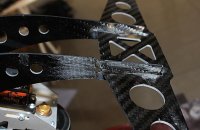I've now read through most of the Hoverfly Gimbal threads and have seen no particular mention of the lag. The board seems to be using a DSP, so lag ought to be better than most other boards. Indeed, Hoverfly themselves are pointing out that the limitation is the mechanical side of things. I believe the video is (somewhat naively) demonstrating very poor servo response.Like a few others I'm sure, I bought 4 Piclocs in the past and had no satisfaction from any of them despite some very good back up and personal help from GM. A nice guy but doesn't want to listen. Until the penny drops with regard to FSR it will be like all of the other crap out there. Maybe it now has, who knows when he doesn't answer emails.
I don't hear any offers of part exchange for something that may now work, or not, as the case may be.
When one considers that you can buy a APM-2 for 199 usd that is a very good FC board and it also has a good set of camera mount outputs. It puts this all into perspective. We are being ripped off.
I was also interested in the Hoverfly Board. Nice bunch of guys with the right qualifications - how could it not work? Just before I got the credit card out I saw this and everything then changed. Sam makes a nice presentation but how could you fail to notice the response lag.
It's a pity too that Hoverfly don't seem to understand what's needed in a "results" demo video - what they are showing so far does nothing to convince us of the board's performance
Do we know what sensors DJI using or have they erased/potted them so we can't see? Their use of direct drive is an obvious mechanical advantage, but what do we know about their sensing and processing?Compare it to this one. I guess you get what you pay for. But having said that I am really unsure about this company. It has grown too fast and does not fall over backwards with any form of after sales service like a lot of the Chinese companies. It is time for someone like Hoverfly to take a close look at this stuff and get on the right track. :tennis:
Exactly what "tried and tested theories" are you referring to? Low FSR gyros, sure. But what else? I totally agree with you about the servos, of course, but the alternatives (for now) are either too heavy, too expensive or both. Let's not forget that the Zenmuse's drive won't scale up cheaply! What would you propose for this "low-end" market?My S/800 Zen that was returned to China has been given a deliberate run around for about a month now, so it is still waiting delivery to the factory.
I know exactly what they are up to.
I have made my own camera mounts for years now using components from mil. spec. obsoletes. Replication is impossible due to the costs involved but DJI took the same tried and tested theories and made it affordable. Is it not time to abandon the stone age following and throw out the servos and flimsy wobbly gimbals and start afresh.

